

Environmental Crime Tops List by Organizations. Main content The most common federal offense committed by “organizational offenders” —corporations, partnerships, unions, trusts, pension funds, and non-profits—was not fraud or money-laundering but environmental crime, according to a report published recently by the U.S.
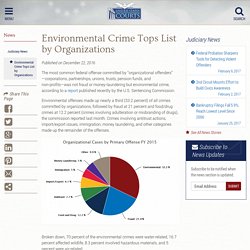
Sentencing Commission. Environmental offenses made up nearly a third (33.2 percent) of all crimes committed by organizations, followed by fraud at 21 percent and food/drug crimes at 12.2 percent (crimes involving adulteration or misbranding of drugs), the commission reported last month. Crimes involving antitrust actions, import/export issues, immigration, money laundering, and other categories made up the remainder of the offenses. Broken down, 70 percent of the environmental crimes were water-related, 16.7 percent affected wildlife, 8.3 percent involved hazardous materials, and 5 percent were air-related. Over half — 58.6 percent — of all organizational cases involved a related individual who was convicted separately. NDPC: FLIR training offered for leak detection.
Home » News Center » Industry News » Posted 9/09/16 (Fri) BISMARCK, N.D. – The North Dakota Petroleum Council (NDPC) will offer training and certification in Optical Gas Imaging using FLIR Technology next week.
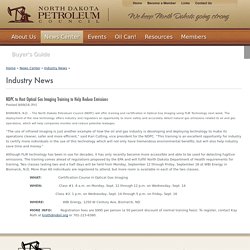
The deployment of the new technology offers industry and regulators an opportunity to more safely and accurately detect natural gas emissions related to oil and gas operations, which will help companies monitor and reduce potential leakages. “The use of infrared imaging is just another example of how the oil and gas industry is developing and deploying technology to make its operations cleaner, safer and more efficient,” said Kari Cutting, vice president for the NDPC.
NAPSR | NATIONAL ASSOCIATION OF PIPELINE SAFETY REPRESENTATIVES. 03.21.14 Issuance of Critical Infrastructure Cybersecurity Framework and Launch of DHS Cyber Community Program. The National Institute of Standards and Technology (NIST) recently released the final “Framework for Improving Critical Infrastructure Cybersecurity.”
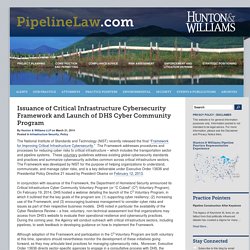
The Framework addresses procedures and processes for reducing cyber risks to critical infrastructure – which includes the transportation sector and pipeline systems. These voluntary guidelines address existing global cybersecurity standards and practices and summarize cybersecurity activities common across critical infrastructure sectors. The Framework was developed by NIST for the purpose of helping organizations to understand, communicate, and manage cyber risks, and is a key deliverable under Executive Order 13636 and Presidential Policy Directive 21 issued by President Obama on February 12, 2013.
Dakota Access Pipeline Facts. PHMSA - Briefing Room - U.S. Transportation Secretary Foxx Appoints 24 Members to the New Pipeline Safety Voluntary Information-Sharing System Working Group. PHMSA 35-16 Thursday, December 15, 2016 Contact: Allie Aguilera Phone: 202-366-5471 U.S.
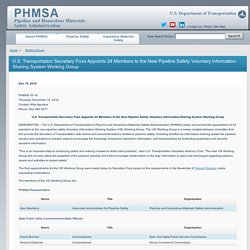
Transportation Secretary Foxx Appoints 24 Members to the New Pipeline Safety Voluntary Information-Sharing System Working Group WASHINGTON – The U.S. Alberta to increase in- situ oilsands monitoring after study finds contaminants. The Alberta government says it will increase environmental monitoring of in-situ oilsands plants following research that shows they can release contaminants into the land and water.

A study released today shows that bitumen extraction using injected steam rather than open-pit mining released low levels of toxins into a small lake near an in-situ site near Cold Lake, Alta. Bill Donahue of Alberta Environment says that’s enough to step up monitoring of all in-situ plants, which now produce more than half of Alberta’s bitumen. Hazardous Materials Rail Shipments: Emergency Responders Receive Support, but DOT Could Improve Oversight of Information Sharing. What GAO Found Emergency planners from most of the 25 selected counties in 17 states that GAO surveyed reported that training for responders and information about rail shipments of hazardous materials affect preparedness.

Emergency planners from almost all of the selected counties reported that a majority of the emergency response personnel, such as fire fighters, who arrive first at an accident receive basic training that would enable them to take initial protective actions, including recognizing hazardous materials and calling for assistance in the event of a rail accident involving crude oil and other hazardous materials. Emergency planners from most counties reported that training related to rail hazardous materials was useful in preparing for accidents. Emergency planners reported that some factors present obstacles to responders' receiving training, such as neglecting one's professional duties to take time off for training. Army Corps of Engineers: Efforts to Assess the Impact of Extreme Weather Events. What GAO Found The U.S.
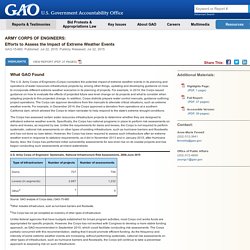
Army Corps of Engineers: Efforts to Assess the Impact of Extreme Weather Events. Army Corps of Engineers: Efforts to Assess the Impact of Extreme Weather Events. Diluted Bitumen Information. A Study of Fate and Behaviour of Diluted Bitumen Oils on Marine Waters December 16, 2013 This document is a final report for a series of physical and chemical tests that were conducted on the fate and behaviour of diluted bitumen oils at a test facility in Gainford, Alberta.

Additionally, as part of this study, a series of tests were conducted to determine the efficiency of various types of oil spill response equipment under similar conditions. Additional Actions Are Needed to Improve Pipeline Safety. What GAO Found Increased oil and gas production presents challenges for transportation infrastructure because some of this increase is in areas with limited transportation linkages.
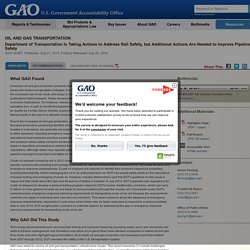
For example, insufficient pipeline capacity to transport crude oil has resulted in the increased use of rail, truck, and barge to move oil to refineries, according to government and industry studies and publications GAO reviewed. These transportation limitations and related effects could pose environmental risks and have economic implications. For instance, natural gas produced as a byproduct of oil is burned—a process called flaring—by operators due, in part, to insufficient pipelines in production areas. In a 2012 report, GAO found that flaring poses a risk to air quality as it emits carbon dioxide, a greenhouse gas linked to climate change, and other air pollutants. Unconventional Oil and Gas Development: Key Environmental and Public Health Requirements.
PHMSA: State by State Record Search. Environmental Health Section - North Dakota Department of Health. Oilfield Environmental Incidents that occurred within the last 12 months which were contained within the boundaries of the production or exploration facility Oilfield Environmental Incidents that occurred within the last 12 months which were not contained, for example, an overflow of the boundaries of the facility or a leak from a facility pipeline Oilfield Environmental Incidents older than 12 months.

PHMSA: State Pipeline Safety Programs. State Agencies Under Section 60105(a) Certification (51) *California PUC does not exercise jurisdiction over municipal operators State Agencies Under Section 60106(a) Agreement (1) *Virginia (municipal systems) State Agencies Acting as Interstate Agents (8) State Pipeline Safety Programs.
PHMSA: Federal and State Authorities' Partnerships. Federal / State Partnerships The U.S. Department of Transportation's (DOT) Pipeline and Hazardous Material Safety Administration (PHMSA), acting through its Office of Pipeline Safety (OPS), administers the national regulatory program to assure safe transportation of natural gas, petroleum, and other hazardous materials by pipeline. The federal/state partnership is the cornerstone for assuring uniform implementation of the pipeline safety program nationwide. Legislative Authority Two statutes provide the framework for the federal pipeline safety program.
Legislative Authorities. Crude Oil Spills and Health - Links to resources about chemicals, side effects, cleanup, and recovery. Overviews Return to top Health Information. TRB Special Report 311: Effects of Diluted Bitumen on Crude Oil Transmission Pipelines. PHMSA - Hazmat Safety Community. PHMSA Contemplates Reducing State Agency Oversight of Interstate Pipelines. PHMSA recently indicated it is contemplating rescinding interstate agency agreements which would reduce state participation in oversight of interstate natural gas and hazardous liquid pipelines. Under the Pipeline Safety Act, states may enter agreements with PHMSA allowing them to take on certain aspects of interstate pipeline transportation oversight, including incident investigations, new construction, and other inspection duties. 49 U.S.C. § 60106.
There are currently 8 states with such authority over interstate natural gas pipelines and 5 states with interstate authority over hazardous liquid lines pursuant to interstate agent agreements. FERC Staff Oil Pipeline Handbooks. Delineation of brine contamination in and near the East Poplar oil field, Fort Peck Indian Reservation, northeastern Montana, 2004-09.
Abstract The extent of brine contamination in the shallow aquifers in and near the East Poplar oil field is as much as 17.9 square miles and appears to be present throughout the entire saturated zone in contaminated areas. The brine contamination affects 15–37 billion gallons of groundwater. Brine contamination in the shallow aquifers east of the Poplar River generally moves to the southwest toward the river and then southward in the Poplar River valley. The likely source of brine contamination in the shallow aquifers is brine that is produced with crude oil in the East Poplar oil field study area. Brine contamination has not only affected the water quality from privately owned wells in and near the East Poplar oil field, but also the city of Poplar’s public water-supply wells. Three water-quality types characterize water in the shallow aquifers; a fourth water-quality type in the study area characterizes the brine.
Breakthrough on "Dirty Diesel“: West African countries to reduce sulphur standards by the factor 60 to 200 12/02/16. Environmental and Energy Ministers from Benin, Ivory Coast, Ghana, Nigeria, and Togo, as well as representatives from the Economic Community of West African States (ECOWAS) attended the meeting in Nigeria’s capitol. The public pressure generated by the massive media coverage on «Dirty Diesel» as well as the campaigns by Public Eye’s partner organizations have led the above mentioned countries to announce the reduction of sulphur levels for imported diesel to 50 ppm.
Swiss Commodity Traders Flood Africa with Toxic Fuel 09/15/16. 2016 National Association of Pipeline Safety Representatives North Dakota Report. 09.29.15 Pipeline Safety Testimony - Government Accountability Office (GAO) Processes affecting oil spills. The figure at right shows the weathering processes affecting oil spills: Adsorption (sedimentation): The process by which one substance is attracted to and adheres to the surface of another substance without actually penetrating its internal structure.
04.05.13 Oil, Gas, Sulphur Operations in the Outer Continental Shelf-Revisions to Safety and Environmental Management Systems. 'Virtually unregulated': Radioactive fracking-waste rules in the US slammed in report. States involved in the fracking boom employ a patchwork of laws to deal with radioactive drilling waste, according to a new report. The US government does not fully regulate disposal, and industry is largely left to self-regulate. The Marcellus Shale in the Appalachian Basin is the center of heightened hydraulic fracturing, or fracking, activity in the US.
PIPELINES: SAFETY, REGULATIONS & REPORTS. ENERGY: INCIDENTS & CONSEQUENCES. Spills, Leaks, Explosions, Contaminations-Porter Ranch, Flint. Landmark Report: New Insights into Impact of Natural Resource Extraction on Taxpayers and Communities. Data on Oil, Gas, Mining Projects Often Incomplete, Missing or Inaccessible. Data on Oil, Gas, Mining Projects Often Incomplete, Missing or Inaccessible.
WMO: Greenhouse gas emissions reach new height. GENEVA, Switzerland, Oct. 24 (UPI) -- Greenhouse gas emissions rose to a symbolic high last year and are at levels more than 40 percent higher than before the Industrial Revolution, a report said. The World Meteorological Organization reported that carbon dioxide, a potent greenhouse gas, reached 400 parts per million in the atmosphere last year for the first time on record. That represents a level that's 44 percent higher than pre-Industrial Revolution levels. In the 15 years since 1990, there was a 37 percent increase in the warming impact on the climate because of the atmospheric influence of greenhouse gases like CO2, methane and nitrous oxide.
WMO Secretary-General Petteri Taalas said in a statement some of the warming was attributed to a recent El Nino weather pattern, though patterns that suggest a warming climate were apparent. "The real elephant in the room is carbon dioxide, which remains in the atmosphere for thousands of years and in the oceans for even longer," he said. U.S. 2 federal agencies open fracking door for California — RT America. Fracking is getting a new lease on life in oil-rich California, much to the dismay of environmental campaigners. Two federal agencies just released reports on offshore drilling there, and found “no significant risk to the environment.” PHMSA - Pipeline Safety Act: Overview & Progress. Word Games are Misleading the American Public About Fracking. Sky TruthWaking Times “Half the truth is often a great lie.” - Benjamin Franklin, Poor Richard’s Almanac – 1758.
The Climate Deception Dossiers: Internal Fossil Fuel Industry Memos Reveal Decades of Corporate Disinformation. For nearly three decades, many of the world's largest fossil fuel companies have knowingly worked to deceive the public about the realities and risks of climate change. Their deceptive tactics are now highlighted in this set of seven "deception dossiers"—collections of internal company and trade association documents that have either been leaked to the public, come to light through lawsuits, or been disclosed through Freedom of Information (FOIA) requests. Each collection provides an illuminating inside look at this coordinated campaign of deception, an effort underwritten by ExxonMobil, Chevron, ConocoPhillips, BP, Shell, Peabody Energy, and other members of the fossil fuel industry.
UPDATE (July 9, 2015): As this report went to press, a newly discovered email from a former Exxon employee revealed that the company was already factoring climate change into decisions about new fossil fuel extraction as early as 1981. Learn more. The climate deception dossiers. Government, Indigenous leaders agree on changes to Muskrat Falls project. Fuel too toxic for Europe sold to Africa’ U-s-agency-lacks-authority-to-set-rules-on-fracking-judge-rules-1. Transparency on Oil, Gas, Coal Revenues Moving Forward. NAPSR 2015 NATIONAL MEETING. ‘Toxic levels of arsenic’: Over half of S. Asia groundwater unusable for 750mn people, study says. USGS Analyzing Land Use Change In Urban Environments 1999. Department of Transportation Is Taking Actions to Address Rail Safety, but Additional Actions Are Needed to Improve Pipeline Safety. Landmark Report on Oil, Gas, Minerals, and Renewable Resources Provides New Insights into the Impact of Natural Resource Extraction on Taxpayers and Communities.
SEC Conflict Minerals Rule: Companies Face Continuing Challenges in Determining Whether Their Conflict Minerals Benefit Armed Groups. Critical Infrastructure Protection: DHS Has Made Progress in Enhancing Critical Infrastructure Assessments but Additional Improvements are Needed. 11.17.16 [Federal Register] Civil Penalty Inflation Adjustment.
Omaha District > Regulatory & Permitting Program. Chemicals In Our Waters Are Affecting Humans And Aquatic Life In Unanticipated Ways. SPCC - Oil Spill Prevention. Public Citizen Press Room. Federal Rules - HAZARDOUS MATERIALS: REVERSE LOGISTICS (RRR); PHMSA-2011-0143 (184230) Oil and Gas: Interior Could Do More to Account for and Manage Natural Gas Emissions. Emission Standards for New and Modified Sources in the Oil and Natural Gas Sector. Federal Rules - HAZARDOUS MATERIALS: FAST ACT REQUIREMENTS FOR FLAMMABLE LIQUIDS AND RAIL TANK CARS; PHMSA-2016-0011 (185845) Pipeline Safety Field Hearing Provides Insight to PHMSA Priorities; Second Hearing Scheduled. 03.09.16 DOT IG Recommends Lowering Pipeline Safety Criminal Liability Standard to ‘Reckless’
06.24.16 Advisory Bulletin Warns About Corrosion Under Insulation. ExpectMore.gov: Department of Transportation Pipeline Safety. ExpectMore.gov: Department of Transportation Pipeline Safety. PHMSA - Oil Spill Response Plans. Pipeline Safety: Safeguarding and Securing Pipelines From Unauthorized Access. EPA begins process to regulate toxic, widely used chemicals. EPA to require mines to offer cleanup assurances. Freight Rail Pricing: Contracts Provide Shippers and Railroads Flexibility, but High Rates Concern Some Shippers. Proposed Joint Fossil Regulation Announced for Interior Department’s Managed Lands.
05.01.15 Oil Train Rule a First Step, But More Needed to Protect Communities. America’s Dangerous Pipelines.